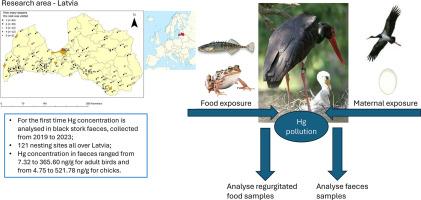波罗的海地区繁殖黑鹳粪便中汞污染的特征
IF 5.4
Q2 ENGINEERING, ENVIRONMENTAL
引用次数: 0
摘要
汞是一种污染物,会对野生动物的体能、繁殖成功率以及觅食和迁徙能力产生负面影响;尤其是对以鱼类为主要食物来源的动物,如黑鹳(Ciconia nigra),风险更大。黑鹳是一种敏感的独居鸟类,近年来由于各种原因,其在欧洲东北部的种群数量有所下降。在这项研究中,我们首次对黑鹳粪便中的汞污染进行了多年评估,分析了六年期间(2018-2023 年)从拉脱维亚各地 121 个巢穴收集的样本。我们发现了总汞污染的时间和空间模式,以及黑鹳幼鸟(范围:4.75-521.78 纳克/克)和成鸟(范围:7.32-365.60 纳克/克)粪便中总汞污染的区别。粪便颜色不同,总汞浓度也不同--浅色粪便的汞浓度比深色粪便的汞浓度低,这在统计学上有显著差异。此外,我们还检测了从巢穴中采集的黑鹳幼鸟食物样本,发现总汞浓度比政府允许的限值高出五倍。不同巢穴以及成年和幼年黑鹳之间的汞污染差异原因仍有待今后研究。本文章由计算机程序翻译,如有差异,请以英文原文为准。

The characterisation of mercury pollution in the faeces of Baltic region breeding black storks
Mercury is a pollutant that negatively impacts wildlife's physical fitness, reproduction success, as well as foraging and migrating abilities; especially high risk is posed to the animals that consume fish as their main food source, such as black storks Ciconia nigra. The black stork is a sensitive and solitary bird species, whose populations in north-eastern Europe have declined in recent years for various reasons. In this study, we present the first-ever multi-year assessment of mercury pollution in black stork faeces, analysing samples collected over a six-year period (2018–2023) from 121 nests across Latvia. We found a temporal and spatial total mercury pollution pattern and a distinction between total mercury pollution in juvenile (range: 4.75–521.78 ng/g) and adult (range: 7.32–365.60 ng/g) black stork faeces. Total mercury concentrations also differed based on faeces colour – light faeces had a statistically significant lower mercury concentration than dark faeces. In addition, we tested juvenile black stork food samples gathered from the nests and found up to five times higher total mercury concentrations than the government-permitted limit. Causes for the variability of mercury pollution across different nest sites as well as between adult and juvenile black storks are still open for future studies.
求助全文
通过发布文献求助,成功后即可免费获取论文全文。
去求助
来源期刊

Journal of hazardous materials advances
Environmental Engineering
CiteScore
4.80
自引率
0.00%
发文量
0
审稿时长
50 days
 求助内容:
求助内容: 应助结果提醒方式:
应助结果提醒方式:


